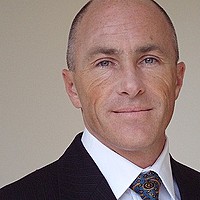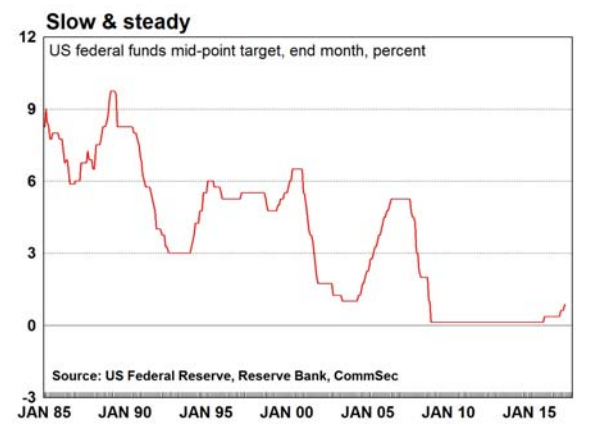Fed rate hike: What does it mean?

CommSec
The US Federal Reserve has lifted the target federal funds range by 25 basis points to 0.75-1.00% as expected. Two more rate hikes are anticipated in 2017 and three in 2018. The US rates decision affects global interest rates, currencies and sharemarkets. So, what happened and what does it mean?
The US Federal Reserve lifted interest rates as expected. In simple terms the economy is doing well, annual inflation is gradually returning to the 2 per cent target level and emergency-level interest rate settings are not justified. Fed policymakers favour another two rate hikes this year. But as always nothing is set in concrete. If there are big tax cuts then the Fed may need to be more aggressive with rate hikes. But if inflation remains tame, the Fed can take its time in lifting rates. It is basically that simple.

The federal funds midpoint target is now 0.875 per cent, still well below the 1.5 per cent cash rate in Australia. The Fed expects the fed funds rate to lift to 2.75-3.00 per cent in the long-term, but that is a long way off.
Some commentators have been critical of the Fed. But things change – politics, oil prices, business and consumer sentiment. There are no guarantees, so you make decisions that are appropriate at the time.
If the Fed does indeed lift rates another two times in 2017, and indeed lifts rates three times as it currently projects in 2018, it will be in response to good economic circumstances. Firm growth in the US and China and improving growth in other parts of the world mean other central banks will look to lift rates.
It is too early to speculate on Australian interest rates. But the US rates move is yet another sign that Australian rates have bottomed. However the Reserve Bank will only lift rates if it believes inflation is headed for 2.5 per cent, meaning more “normal” rate settings are required.
It is important to highlight that the world has changed. Inflation is lower, globalisation and technology are keeping inflationary pressures low and interest rates are likely to peak at lower levels than in the past. Rate settings are still very accommodative across the globe, and that includes the US even after recent rate hikes.
The Aussie dollar rose over US1 cent in response to the Fed decision. Other currencies also rose – the main reason being that some investors thought the Fed would lift rates four times in total this year while the Fed is only flagging three hikes. The Aussie also lifted in line with higher commodity prices.
The higher Aussie dollar is positive for travelers and those looking to buy imported goods. But the higher Aussie is less positive for exporters and the tourism sector.
The health of the US economy, together with the data earlier this week showing good Chinese economic growth, are positives for the resources sector. The perception is that stronger business and consumer spending means stronger demand for raw materials and potentially higher prices.
2 topics

I am married with three children (all in their 20s) and currently live in Huntleys Cove in the inner west of Sydney. Chief interest is athletics and trying to keeping up with the children.My current role is Chief Economist, Commonwealth...
Expertise
No areas of expertise

I am married with three children (all in their 20s) and currently live in Huntleys Cove in the inner west of Sydney. Chief interest is athletics and trying to keeping up with the children.My current role is Chief Economist, Commonwealth...
Expertise
No areas of expertise
